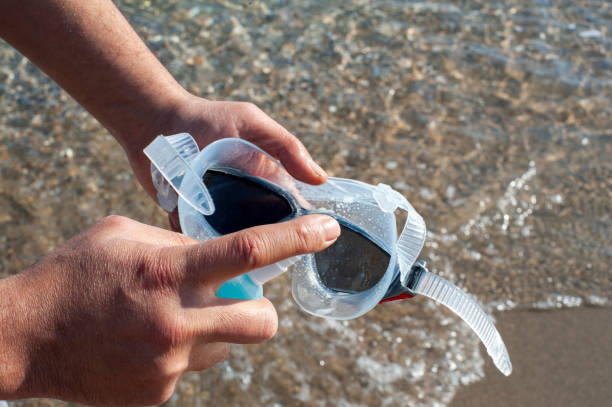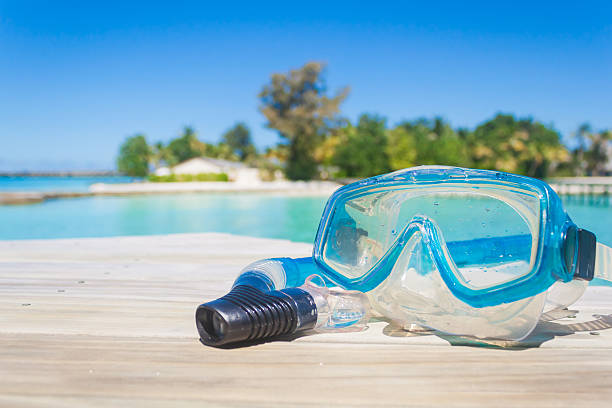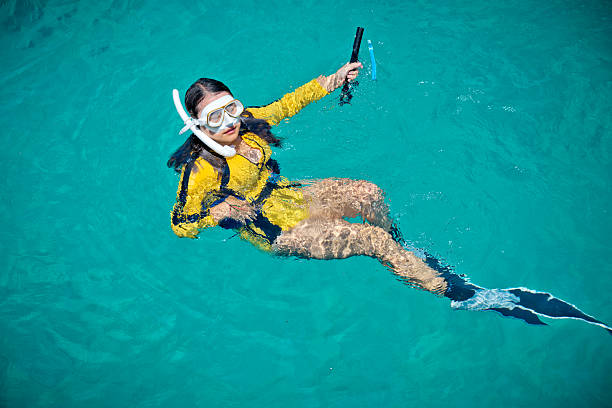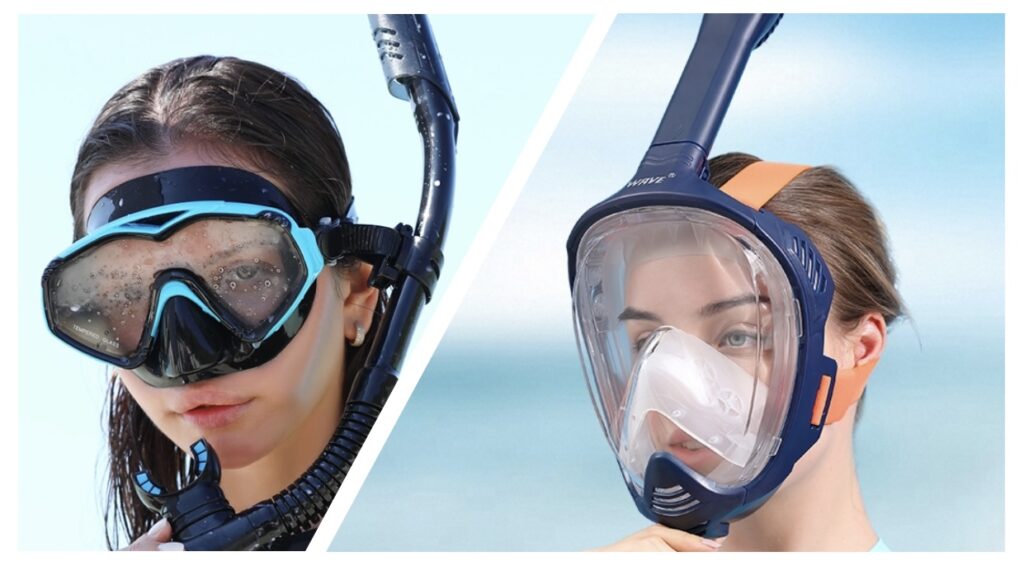
Snorkeling is a popular activity that allows individuals to explore the vibrant underwater world. One key aspect of this activity is choosing the right snorkel mask, which greatly impacts the overall experience. In this article, we will delve into the debate about full-face snorkel masks vs. traditional snorkel masks, exploring their pros and cons to help you make an informed decision.
What Is A Full Face Snorkel Mask?
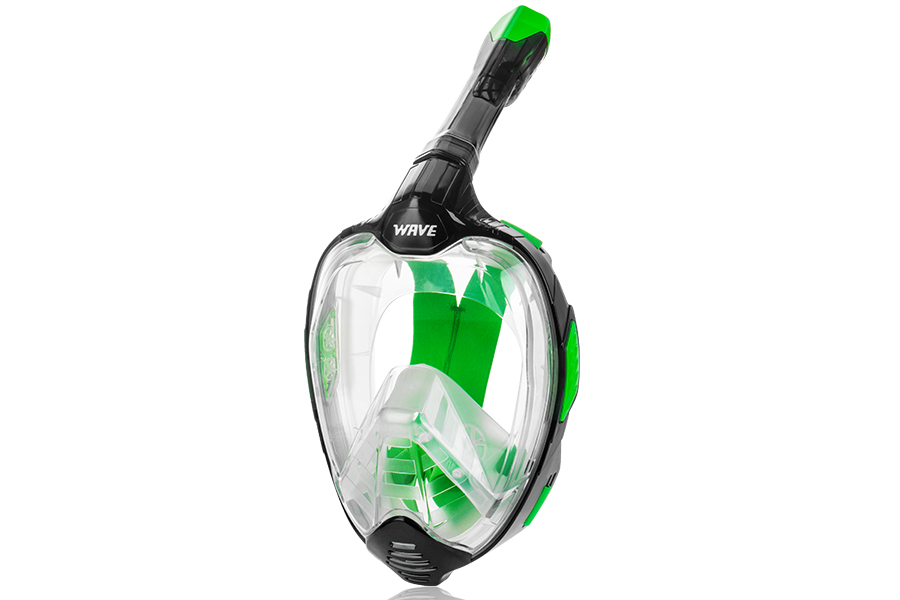
A full-face snorkel mask, also called a full-face diving mask, is a revolutionary piece of equipment that combines a mask and snorkel into one unit. Designed to cover the entire face, it offers a broader view and a more natural breathing experience. The purpose of this mask is to provide comfort and convenience to snorkelers, especially beginners who may find the traditional mask intimidating.
How Do Full-Face Snorkel Masks Work?
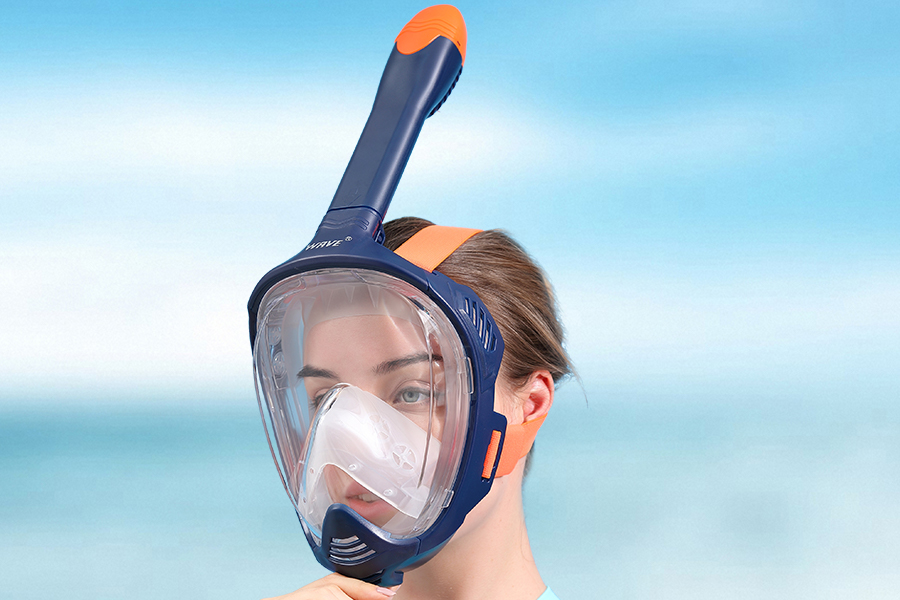
It integrates the mask and breathing tube into a single unit. Breathing occurs naturally through the nose and mouth, and the mask covers the entire face, providing a panoramic underwater view.
Pros and Cons of Full Face Snorkel Masks
Before using full-face snorkel masks, you should explore their benefits and drawbacks to uncover which option suits your underwater adventures best.
Pros
- Enhanced breathing experience
- Greater ease of use for beginners
- Reduced fogging and leakage issues
Enhanced breathing experience: Unlike traditional masks, full-face snorkel masks allow you to breathe through both your nose and mouth. This feature eliminates the discomfort of breathing through a snorkel tube and promotes a more natural respiratory rhythm.
Greater ease of use for beginners: Full-face masks are perfect for beginners as they provide a sense of security and confidence in the water. The larger viewing area also helps reduce feelings of claustrophobia.
Reduced fogging and leakage issues: Advanced ventilation systems in whole-face snorkel masks minimize fogging, ensuring clear visibility underwater. Additionally, the watertight seal prevents water from entering the mask, eliminating leakage problems.
Cons
- Potential CO2 buildup
- Difficulty in equalizing pressure
- Limited customization options
Potential CO2 buildup: Full-face masks create a closed system that can trap exhaled carbon dioxide (CO2), leading to breathing difficulties if not properly managed. It is essential to follow manufacturer guidelines and frequently exhale forcefully to avoid CO2 buildup.
Difficulty in equalizing pressure: Equalizing pressure is crucial when snorkeling at deeper depths. Snorkeling full face masks may pose challenges in equalizing pressure due to the absence of a dedicated nose pocket. It is important to practice equalization techniques or opt for traditional masks for deeper dives.
Limited customization options: Full-face masks for snorkeling are designed to fit a wide range of face shapes and sizes, but they may not offer the same level of customization as traditional masks. Individuals with unique facial features may find it challenging to achieve a snug fit.
What Is A Traditional Snorkel Mask?
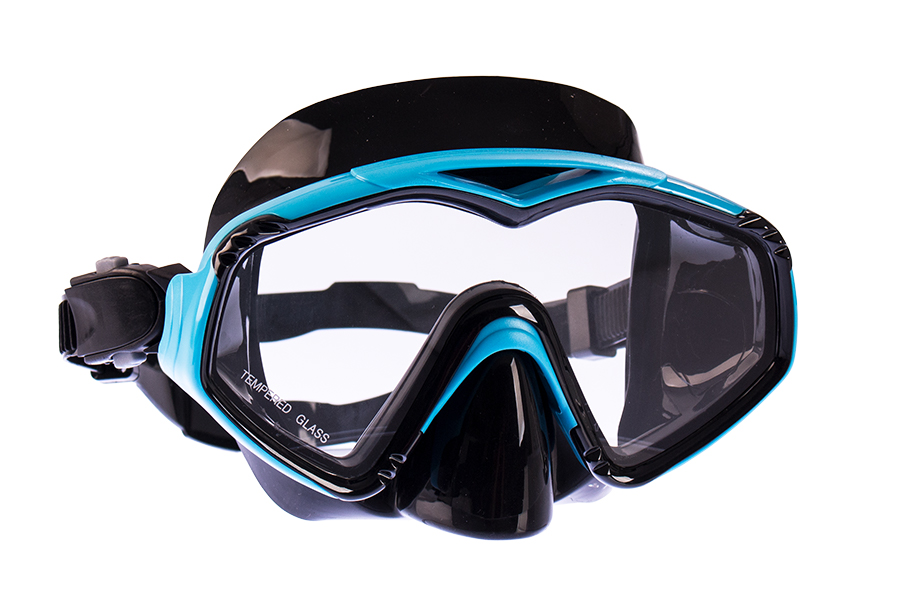
A traditional mask & snorkel set, also called a half mask, dive mask, or scuba mask, consists of a snorkel mask, snorkel tube, and possibly a pair of snorkeling fins. These masks cover only the eyes, nose, and mouth, leaving the rest of the face exposed. Traditional masks have been used for years and are known for their reliability and versatility.
How Do Traditional Snorkel Masks Work?
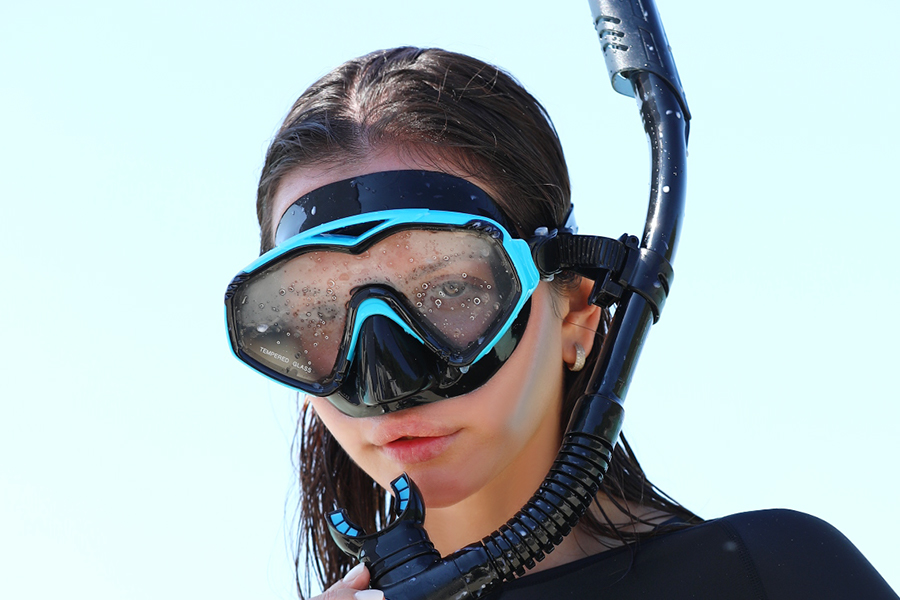
It consists of separate pieces: a mask covering the eyes and nose, and a breathing tube extending above the water surface. Users breathe through their mouth via the tube, while the mask provides underwater vision.
Pros and Cons of Traditional Snorkel Masks
Before using traditional snorkel masks, you should explore their benefits and drawbacks to uncover which option suits your underwater adventures best.
Pros
- Adjustable fit for individual preferences
- Easy to clear water from the mask
- Ability to replace parts if needed
Adjustable fit for individual preferences: Traditional snorkel masks often come with adjustable straps, allowing for a customized fit based on individual preferences. This ensures comfort and minimal water entry during snorkeling.
Easy to clear water from the mask: Traditional masks provide snorkelers with the ability to easily clear water from the mask by exhaling forcefully through the nose.
Ability to replace parts if needed: If a component of a traditional snorkel mask set gets damaged or worn out, it is usually easy to replace the specific part without having to purchase an entirely new mask.
Cons
- Learn curve for breathing techniques
- Potential leakage and fogging problems
- Lower field of vision compared to full face masks
Learning curve for breathing techniques: Beginner snorkelers may find it challenging to master proper breathing techniques with a traditional mask. Breathing exclusively through the mouth can feel unnatural initially, but with practice, it becomes second nature.
Potential leakage and fogging problems: Traditional masks may sometimes experience leakage and fogging, which can hinder visibility and overall snorkeling experience. Regular maintenance and proper fitting can help minimize these issues.
Lower field of vision compared to full face masks: Traditional masks have a smaller viewing area, limiting peripheral vision. This can be a disadvantage when exploring underwater landscapes and marine life.
Differences Between Full Face And Traditional Snorkel Mask
The choice between full-face and traditional snorkel masks can greatly impact your snorkeling experience. While traditional masks offer a classic design, full-face masks provide a more comfortable and immersive experience, with unique features and benefits that set them apart. But their differences are not just about the exterior design, let’s know more about the deeper sections.
Breathing Mechanism: How They Differ in Terms of Airflow
Full-face snorkel masks offer the convenience of breathing through both the nose and mouth, resembling natural breathing.
In contrast, traditional snorkel masks rely on breathing solely through the mouth, which can feel restrictive at times.
Field of Vision: Comparing Visibility and Peripheral Vision
Snorkeling full face mask provides a wider field of vision, covering the entire face, allowing snorkelers to enjoy a panoramic view of the underwater world.
Traditional masks have a smaller viewing area, limiting the peripheral vision.
Comfort and Fit: Examining the Ergonomic Aspects of Both Mask Types
Full-face masks are generally more comfortable for beginners and individuals with sensitive facial skin. They provide a snug fit and eliminate the need to bite on a mouthpiece.
Traditional masks can be adjusted to achieve a customized fit, but may not be as comfortable for extended periods due to the pressure on the jaw.
Comparison Table about Full Face Snorkel Mask And Traditional Snorkel Mask
| Types | Full Face Snorkel Mask | Traditional Snorkel Mask |
| Breathing Mechanism | Allows breathing through both nose and mouth | Requires breathing through the mouth only |
| Field of Vision | Offers a wider field of vision, covering the entire face | Provides a smaller viewing area, limited peripheral vision |
| Comfort and Fit | Generally more comfortable, snug fit without a mouthpiece to bite on | Adjustable fit may cause discomfort with prolonged use |
| CO2 Buildup | Potential for CO2 buildup | No CO2 buildup |
| Equalizing Pressure | Can pose difficulties in equalizing pressure due to the absence of a dedicated nose pocket | Enables easier equalization by pinching the nose and blowing gently |
| Customization Options | Limited customization options for individuals with unique facial features | Adjustable straps and options for replacement parts |
| Ease of Use for Beginners | Great for beginners, provides a sense of security and confidence | May require some practice to get used to breathing techniques |
| Water Clearing | Advanced ventilation systems reduce fogging; a watertight seal prevents leakage | May experience leakage and fogging, requires regular maintenance for optimal performance |
| Snorkeling Conditions | Ideal for calm, shallow waters | Suitable for various conditions including deeper dives |
| Recommended for | Beginners, individuals with sensitive facial skin | Those who prefer a traditional mask and are comfortable with breathing only through the mouth |
Which is Better: Full Face or Traditional Snorkel Mask?
When it comes to full-face snorkel masks vs. traditional snorkel masks, the question of which is better is subjective and depends on various factors.
Experience Level: Full-face snorkel masks are ideal for beginners, providing comfort and ease of use. Traditional masks are better suited for experienced snorkelers who are comfortable with breathing only through the mouth.
Comfort Preferences: Full-face masks offer more comfort and a snug fit, while traditional masks can be adjusted for a personalized fit.
Snorkeling Goals: Full-face masks are great for calm, shallow waters, whereas traditional masks are more versatile and suitable for various conditions including deeper dives.
All in all, snorkeling full face masks are suitable for beginners, and individuals with sensitive facial skin, while traditional or regular snorkel mask suits those who are comfortable with breathing only through the mouth.
Conclusion
Choosing the right snorkel mask is crucial for a fulfilling and enjoyable snorkeling experience. We have explored the differences between full-face and traditional snorkel masks, weighing their pros and cons. Ultimately, the decision comes down to personal preferences, comfort, and the specific snorkeling conditions. Take the time to assess your needs and follow the guidelines provided to make an informed decision. To explore more about snorkeling, you can also read All You Need to Know About Snorkeling.
FAQs on Snorkel Mask
- How does the full–face snorkel mask work?
A full-face snorkel mask covers the entire face, providing a larger viewing area and allowing snorkelers to breathe through both the nose and mouth. It uses a separate chamber for exhaled air and includes an advanced ventilation system to minimize fogging and ensure proper airflow.
- How to measure a full–face snorkel mask?
Measure the distance from the bridge of your nose to the bottom of your chin to determine the right size for a full-face snorkel mask.
- What size snorkel mask do I need?
The size of the snorkel mask depends on individual face dimensions. Most manufacturers provide size charts that correlate facial measurements with mask sizes. It is essential to follow these guidelines to ensure a proper fit and optimal performance.
- Are Full–Face Snorkel Masks Safe?
When used correctly and following manufacturer guidelines, full-face snorkel masks can be safe. It is important to be aware of potential CO2 buildup and the need to practice proper breathing techniques. Snorkelers should also be mindful of their limits and regularly inspect and maintain the mask for optimal safety.
- How to breathe underwater with a snorkel mask?
Breathe underwater with a snorkel mask by ensuring a proper fit and seal. Keep the snorkel tube above water, relax your jaw, and breathe slowly through your mouth. Exhale gently to clear any water from the snorkel. Take breaks and practice good breathing techniques.
